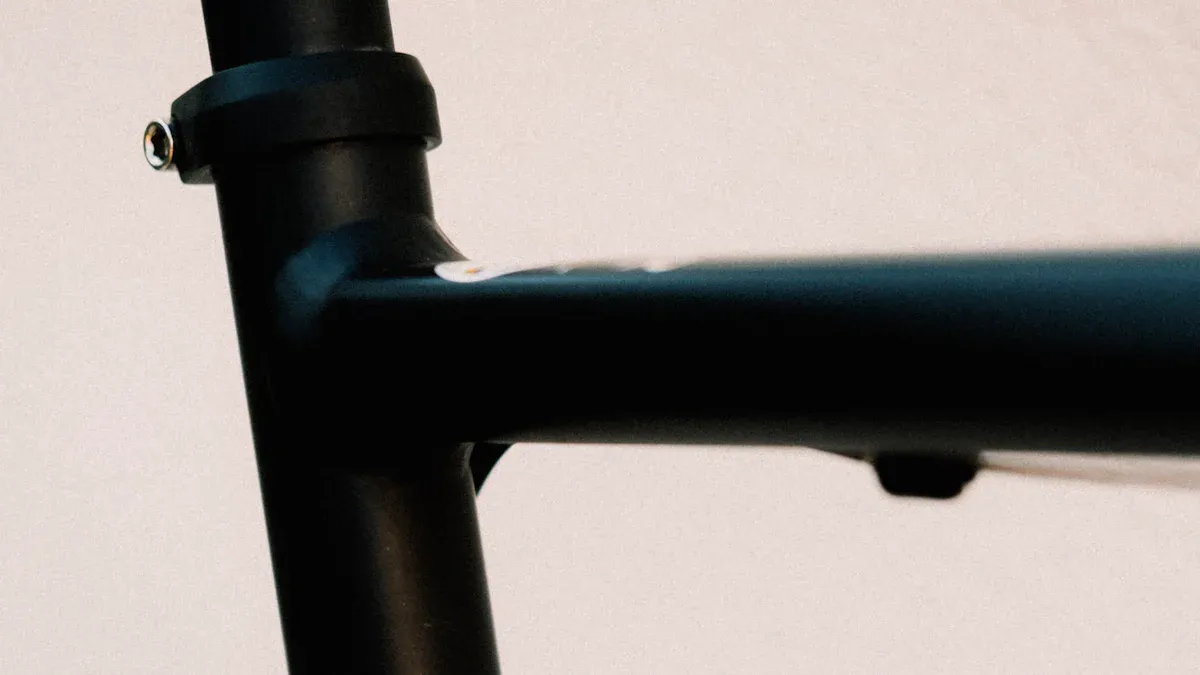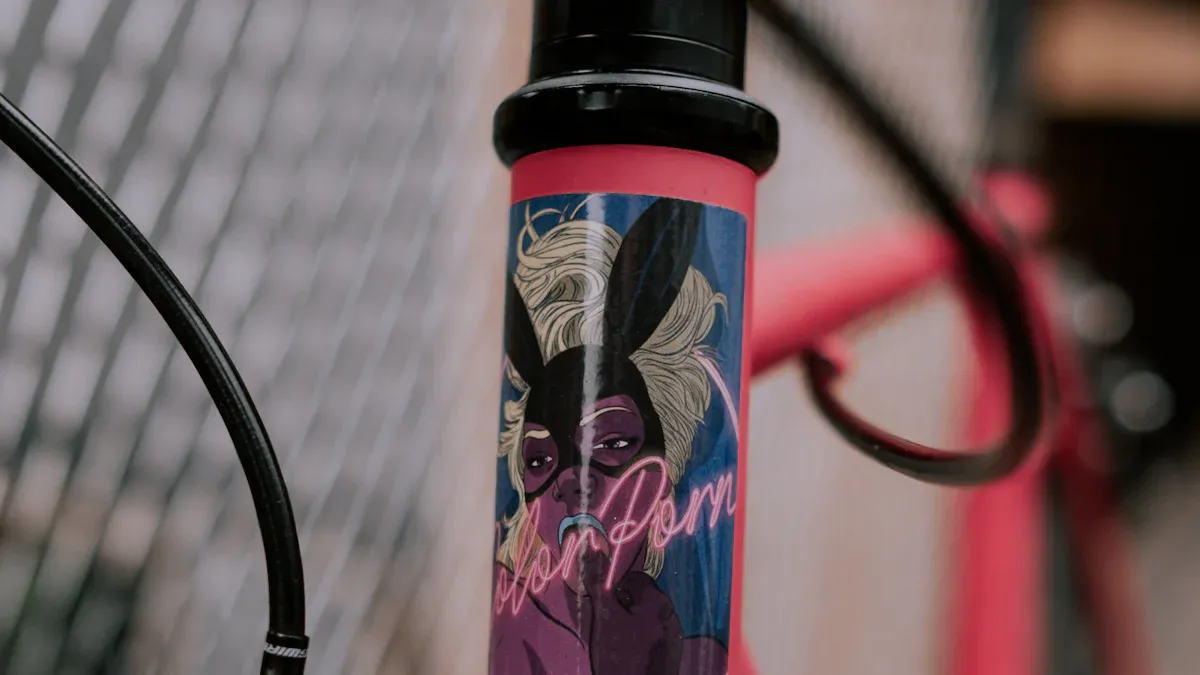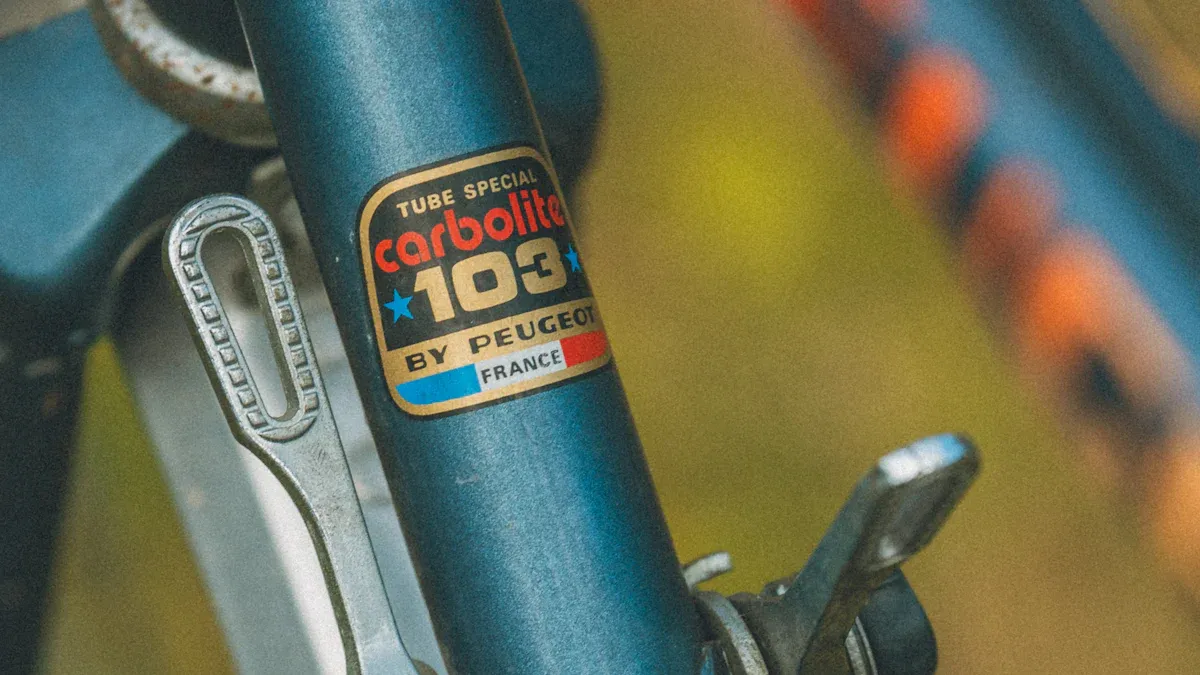
When you think about cycling, the road bike frame part names are very important. It’s not just a structure; it’s where comfort and performance meet. In the last ten years, materials like aluminum and carbon fiber have become very popular in cycling. Aluminum frames, for example, sold over 13 million units in 2023. They make up more than 60% of the market. They are popular because they are cheap and strong. This makes them great for commuters and new cyclists. On the other hand, carbon fiber frames are light. Professionals like them because they want speed and efficiency.
Here’s a quick look at the current trends:
Frame Material | Units Sold (2023) | Market Share (%) | Characteristics |
|---|---|---|---|
Aluminum | Over 13 million | Over 60% | Affordable, moderate weight, durable |
Carbon Fiber | Over 7.5 million | About 40% | Lightweight, superior vibration dampening |
Knowing about these materials helps you understand the important road bike frame part names.
Key Takeaways
Knowing about frame materials helps you pick the right bike. Aluminum is cheap and strong. Carbon fiber is light and fast.
The shape of the bike frame affects your comfort and how well you ride. Look at the angles and lengths of the tubes for a better ride.
Check your bike’s headset often for smooth steering. A good headset gives you better control and lasts longer.
Changing your saddle height is important for comfort. A well-placed saddle makes you ride better and lowers injury chances.
Understanding the roles of different frame parts, like the top tube and down tube, helps you see how your bike works and makes cycling more enjoyable.
Frame Overview
The frame is the main part of your road bike. It keeps everything together and is very important for how your bike works. Think of it like the base of a house. Without a strong frame, everything else can break. The frame changes how you ride by deciding how the bike feels and fits you. It affects comfort, speed, and balance.
Here’s a quick look at the main jobs of a road bike frame:
Function | Description |
|---|---|
The frame changes how the bike moves and works, affecting how you feel while riding. | |
Determines fit and geometry | The shape and build of the frame decide how well the bike fits the rider, affecting comfort. |
Material composition | Modern frames are often made from carbon fiber, balancing strength and flexibility. |
When it comes to materials, you have many choices, each with good and bad points. Here’s a list of the most common materials used in road bike frames:
Material | Advantages | Disadvantages | Ideal For |
|---|---|---|---|
Carbon Fiber | Strong and light, can be made to fit your ride, absorbs bumps, flexible design, won’t rust | Expensive, can break easily, hard to fix, not eco-friendly | Riders who want high performance, racing, or comfort on long rides. |
Aluminum | Good price, decent weight, strong, lasts long, easy to make | Can feel rough, wears out over time, hard to repair, less flexible design | Riders on a budget, beginners, racers in risky events, reliable training bikes. |
Steel | Great ride feel, lasts long, easy to fix, looks nice, can be customized | Heavier than other materials, can rust, not as strong, harder to find | Riders who want comfort, touring cyclists, bikepackers, those who like classic looks. |
Titanium | Amazing ride feel, lasts long, resists wear, natural look, strong and light | Very expensive, hard to make, less flexible design, tough to repair | Cyclists looking for a top-quality, long-lasting bike, valuing ride feel and strength. |
Choosing the right frame material can really change your cycling experience. Whether you’re just starting or have been cycling for years, knowing these road bike frame part names will help you make smart choices.
Top Tube

The top tube is a key part of your road bike frame. It connects the head tube at the front to the seat tube at the back. This connection plays a big role in the overall structure of the bike. Think of the top tube as a bridge that helps keep everything stable. Without it, the bike would lack strength and balance. The dimensions of the top tube, like its length and angle, are crucial. They influence how the bike handles and how comfortable you feel while riding.
When you consider bike geometry, the top tube’s length can make a significant difference. A longer top tube gives you a more stretched-out position. This position can help you cut through the wind, making you more aerodynamic. However, it might not be the best choice for long rides, as it can lead to discomfort. On the other hand, a shorter top tube can create a more upright position. While this might feel more comfortable, it can also make you feel cramped, especially if your knees start hitting your elbows.
Here’s a quick look at how different top tube lengths affect your ride:
Top Tube Length | Effect on Rider Position | Comfort Level |
|---|---|---|
Longer | More stretched out, aggressive position | Potentially less comfortable for long rides |
Shorter | Cramped positioning, knees hitting elbows | Can lead to discomfort |
Head Tube

The head tube is a crucial part of your road bike frame. It connects the front fork to the frame and plays a significant role in steering. When you turn the handlebars, the head tube allows the front wheel to pivot, helping you navigate corners and obstacles. The angle of the head tube also affects how your bike handles.
Here’s how the head tube angle influences your ride:
A steeper head tube angle helps with balance at low speeds. However, it can lead to oversteering if you’re not careful.
A slacker head tube angle provides more stability at high speeds. This makes your bike less likely to make sudden directional changes.
Understanding these angles can help you choose a bike that fits your riding style.
Now, let’s talk about the headset. The headset is a bearing assembly that connects the bike’s fork steerer tube to the head tube. It allows for smooth steering and control. By reducing friction, the headset ensures that you can steer your bike easily, even on rough terrain. A well-maintained headset evenly distributes forces, which is essential for keeping your ride stable and responsive.
If your headset is missing or damaged, you might experience stiff or loose steering. This can increase wear on both the frame and fork, making it harder to control your bike. Regular servicing of your headset is vital. Dirt and moisture can contaminate the bearings, leading to rough steering and uneven wear. Keeping your headset clean and well-lubricated ensures smooth steering and extends its lifespan, especially in tough conditions.
Down Tube
The down tube is a vital component of your road bike frame. It runs from the head tube down to the bottom bracket, forming a strong backbone for the entire structure. You can think of it as the main support beam in a building. Its strength is crucial because it helps the bike withstand the forces you encounter while riding.
Here are a couple of reasons why the down tube is so important for strength:
The down tube is typically the most massive part of the frame, with the largest cross-section. This design allows it to handle significant forces during your rides.
It manages torsional and lateral stiffness, which is critical for precise handling and efficient power transfer. When you pedal, you want every ounce of energy to go into moving forward, and a sturdy down tube helps make that happen.
Now, let’s talk about how the down tube connects to the bottom bracket. This connection is essential for your bike’s structural integrity and stiffness. A stiff interface between the down tube and bottom bracket enhances power transfer efficiency. When you push down on the pedals, you want that energy to flow smoothly to the drivetrain.
Bike designers have long prioritized keeping the bottom bracket area strong. This focus directly affects how well you can transfer power from your legs to the wheels. If the connection is weak, you might lose energy, making your ride less efficient.
Seat Tube
The seat tube is an essential part of your road bike frame. It runs vertically from the bottom bracket up to the saddle. Think of it as the backbone that supports your seat. Without a sturdy seat tube, you wouldn’t have a reliable place to sit while you ride.
When you adjust your saddle height, you’re directly interacting with the seat tube. A well-positioned saddle helps you maintain comfort and control. If your saddle is too low or too high, it can lead to discomfort and even injury. So, getting that height just right is crucial for an enjoyable ride.
Now, let’s talk about how the seat tube connects to the bottom bracket. This connection is vital for your bike’s overall performance. The angle of the seat tube plays a significant role in how you sit over the pedals. Here are some key points to consider:
A steeper seat tube angle positions you optimally over the pedals. This enhances power transfer and reduces muscle fatigue.
An ideal angle allows for adjustments that optimize fit and efficiency.
If the angle is too slack, it can hinder your performance just as much as one that is too steep.
When you pedal, a well-aligned seat tube helps activate your muscles effectively. This positioning improves your climbing and sprinting capabilities, leading to increased pedaling efficiency. On the flip side, a slacker angle can lead to inefficient pedaling and increased stress on your knees.
Seat Stays and Chain Stays
Seat stays are the parts of your road bike frame that connect the top tube to the rear dropouts. They play a crucial role in the bike’s overall structure and ride quality. When you ride on rough surfaces, the design of the seat stays can make a big difference. For instance, when seat stays are dropped, they enhance compliance and comfort. This design allows the seat tube to flex more, which helps absorb road vibrations and impacts. A smaller rear triangle, achieved by dropping the seat stays, contributes to a more comfortable ride by allowing greater movement at the saddle. So, if you want a smoother experience on bumpy roads, look for bikes with well-designed seat stays.
Now, let’s talk about chain stays. These are the parts that run parallel to the ground, connecting the bottom bracket to the rear dropouts. Chain stays are essential for transferring power from your legs to the wheels. When you pedal, the force you generate travels through the chain stays. A stiff chain stay design ensures that most of your energy goes directly into moving the bike forward. If the chain stays flex too much, you might lose some of that power, making your ride less efficient.
Here’s a quick summary of how these components work together:
Seat Stays:
Connect the top tube to the rear dropouts.
Enhance comfort by absorbing road vibrations.
Allow for greater movement at the saddle.
Chain Stays:
Connect the bottom bracket to the rear dropouts.
Transfer power efficiently from your legs to the wheels.
A stiffer design improves energy transfer.
Understanding these road bike frame part names helps you appreciate how your bike works. Whether you’re a beginner or an experienced cyclist, knowing about seat stays and chain stays can guide you in choosing the right bike for your needs.
Knowing the important parts of a road bike frame can really improve your cycling fun. Each part is key for how well the bike works, how comfy it is, and how it fits you. Here’s a quick look at why these parts are important:
Component | Importance |
|---|---|
Frame Material | Changes weight, strength, and stiffness, which affects how the bike handles and performs. |
Affects comfort, stability, and handling based on angles and lengths of the tubes. | |
Frame Design | Includes shape and welding methods that impact power transfer, comfort, and speed. |
Compatibility | Makes sure the frame fits with other parts and allows for changes. |
Overall Performance | A good frame design boosts cycling performance, comfort, and your riding experience. |
By understanding these ideas, you can make smart choices when picking your next bike. Whether you want a classic frame for stability or a smaller design for quick moves, knowing what to check helps you find the best fit for your riding style. Enjoy cycling! 🚴♂️
FAQ
What is the most important part of a road bike frame?
The frame is the most important part. It gives your bike structure and stability. A strong frame helps your bike handle better. It also makes your ride more comfortable and efficient.
How do I choose the right frame material?
Think about your riding style and how much money you have. Aluminum is cheap and strong. Carbon fiber is light and fast. Steel is comfy, and titanium is for those who want the best quality.
What does bike geometry mean?
Bike geometry means the angles and lengths of the frame tubes. It changes your riding position, comfort, and how the bike handles. Good geometry makes your cycling experience better.
How often should I check my bike’s headset?
You should check your headset often. Do this especially if steering feels stiff or loose. Keeping it clean and lubricated helps with smooth handling and makes it last longer.
Can I adjust my saddle height easily?
Yes! It’s easy to change your saddle height. Just loosen the seat post clamp, move the saddle up or down, and tighten the clamp again. Getting the right height is important for comfort and efficiency.
See Also
Understanding Bike Frame Components And Their Key Functions
Essential Components Of Bike Frames And Their Functions
How Track Bike Frames Differ From Standard Bike Frames
